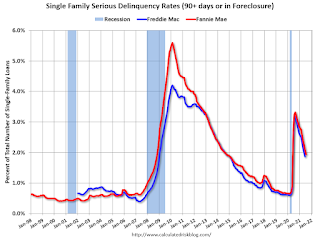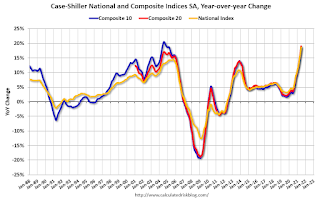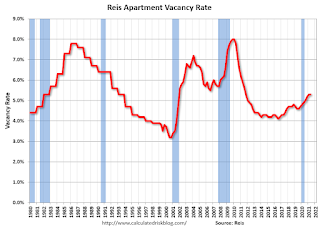by Calculated Risk on 8/31/2021 04:21:00 PM
Tuesday, August 31, 2021
Fannie Mae: Mortgage Serious Delinquency Rate Decreased in July
Fannie Mae reported that the Single-Family Serious Delinquency decreased to 1.94% in July, from 2.08% in June. The serious delinquency rate is down from 3.24% in July 2020.
These are mortgage loans that are "three monthly payments or more past due or in foreclosure".
The Fannie Mae serious delinquency rate peaked in February 2010 at 5.59% following the housing bubble, and peaked at 3.32% in August 2020 during the pandemic.

By vintage, for loans made in 2004 or earlier (1% of portfolio), 4.82% are seriously delinquent (down from 5.04% in June). For loans made in 2005 through 2008 (2% of portfolio), 8.26% are seriously delinquent (down from 8.75%), For recent loans, originated in 2009 through 2021 (97% of portfolio), 1.57% are seriously delinquent (down from 1.69%). So Fannie is still working through a few poor performing loans from the bubble years.
Mortgages in forbearance are counted as delinquent in this monthly report, but they will not be reported to the credit bureaus.
This is very different from the increase in delinquencies following the housing bubble. Lending standards have been fairly solid over the last decade, and most of these homeowners have equity in their homes - and they will be able to restructure their loans once they are employed.
August 31st COVID-19: Cases May be Peaking at Average 150,000 per Day
by Calculated Risk on 8/31/2021 03:26:00 PM
| COVID Metrics | ||||
|---|---|---|---|---|
| Today | Week Ago | Goal | ||
| Percent fully Vaccinated | 52.4% | 51.6% | ≥70.0%1 | |
| Fully Vaccinated (millions) | 174.1 | 171.4 | ≥2321 | |
| New Cases per Day3 | 149,263 | 145,423 | ≤5,0002 | |
| Hospitalized3🚩 | 90,279 | 85,350 | ≤3,0002 | |
| Deaths per Day3🚩 | 985 | 883 | ≤502 | |
| 1 Minimum to achieve "herd immunity" (estimated between 70% and 85%). 2my goals to stop daily posts, 37 day average for Cases, Currently Hospitalized, and Deaths 🚩 Increasing 7 day average week-over-week for Cases, Hospitalized, and Deaths ✅ Goal met. | ||||
IMPORTANT: For "herd immunity" most experts believe we need 70% to 85% of the total population fully vaccinated (or already had COVID).
The following 14 states and D.C. have between 50% and 59.9% fully vaccinated: New Hampshire at 59.7%, Oregon, District of Columbia, Virginia, Colorado, Minnesota, California, Hawaii, Delaware, Pennsylvania, Wisconsin, Florida, Nebraska, Iowa, Illinois, and Michigan at 50.5%.
Next up (total population, fully vaccinated according to CDC) are South Dakota at 49.1%, Kentucky at 48.5%, Ohio at 48.4%, Kansas at 48.3%, Arizona at 47.9%, Nevada at 47.8%, Utah at 47.5%, Texas at 47.4% and Alaska at 47.2%.
 Click on graph for larger image.
Click on graph for larger image.This graph shows the daily (columns) and 7 day average (line) of positive tests reported.
House Prices Increase Sharply in June
by Calculated Risk on 8/31/2021 01:26:00 PM
New newsletter article: House Prices Increase Sharply in June
I've started a newsletter focused solely on real estate. This newsletter will be ad free.
You can subscribe at https://calculatedrisk.substack.com/ (Currently all content is available for free, but please subscribe).
Reis: Office and Mall Vacancy Rates Increased in Q2
by Calculated Risk on 8/31/2021 10:59:00 AM
 Click on graph for larger image.
Click on graph for larger image.The first graph shows the office vacancy rate starting in 1980 (prior to 1999 the data is annual).
Reis also reported that office effective rents declined in Q2; the fifth consecutive quarter with declining rents.
 The second graph shows the regional and strip mall vacancy rate starting in 1980 (prior to 2000 the data is annual).
The second graph shows the regional and strip mall vacancy rate starting in 1980 (prior to 2000 the data is annual).For Neighborhood and Community malls (strip malls), the vacancy rate was 10.5% in Q2, down from 10.6% in Q1, and up from 10.2% in Q2 2020.
For Regional malls, the vacancy rate was 11.5% in Q2, up from 11.4% in Q1, and up from 9.8% in Q2 2020.
All vacancy data courtesy of Reis
Case-Shiller: National House Price Index increased 18.6% year-over-year in June
by Calculated Risk on 8/31/2021 09:13:00 AM
S&P/Case-Shiller released the monthly Home Price Indices for June ("June" is a 3 month average of April, May and June prices).
This release includes prices for 20 individual cities, two composite indices (for 10 cities and 20 cities) and the monthly National index.
From S&P: S&P Corelogic Case-Shiller Index Shows Annual Home Price Gain Topped 18.6% In June
The S&P CoreLogic Case-Shiller U.S. National Home Price NSA Index, covering all nine U.S. census divisions, reported a 18.6% annual gain in June, up from 16.8% in the previous month. The 10-City Composite annual increase came in at 18.5%, up from 16.6% in the previous month. The 20-City Composite posted a 19.1% year-over-year gain, up from 17.1% in the previous month.
Phoenix, San Diego, and Seattle reported the highest year-over-year gains among the 20 cities in June. Phoenix led the way with a 29.3% year-over-year price increase, followed by San Diego with a 27.1% increase and Seattle with a 25.0% increase. All 20 cities reported higher price increases in the year ending June 2021 versus the year ending May 2021.
...
Before seasonal adjustment, the U.S. National Index posted a 2.2% month-over-month increase in June, while the 10-City and 20-City Composites both posted increases of 1.8% and 2.0%, respectively.
After seasonal adjustment, the U.S. National Index posted a month-over-month increase of 1.8%, and the 10-City and 20-City Composites both posted increases of 1.6% and 1.8%, respectively. In June, all 20 cities reported increases before and after seasonal adjustments.
“June 2021 is the third consecutive month in which the growth rate of housing prices set a record, says Craig J. Lazzara, Managing Director and Global Head of Index Investment Strategy at S&P DJI. “The National Composite Index marked its thirteenth consecutive month of accelerating prices with an 18.6% gain from year-ago levels, up from 16.8% in May and 14.8% in April. This acceleration is also reflected in the 10- and 20-City Composites (up 18.5% and 19.1%, respectively). The last several months have been extraordinary not only in the level of price gains, but in the consistency of gains across the country. In June, all 20 cities rose, and all 20 gained more in the 12 months ended in June than they had gained in the 12 months ended in May. Home prices in 19 of our 20 cities (all but Chicago) now stand at all-time highs, as do the National Composite and both the 10- and 20-City indices.
June’s 18.6% price gain for the National Composite is the highest reading in more than 30 years of S&P CoreLogic Case-Shiller data. This month, Boston joined Charlotte, Cleveland, Dallas, Denver, and Seattle in recording their all-time highest 12-month gains. Price gains in all 20 cities were in the top quartile of historical performance; in 19 cities, price gains were in top decile.
We have previously suggested that the strength in the U.S. housing market is being driven in part by reaction to the COVID pandemic, as potential buyers move from urban apartments to suburban homes. June’s data are consistent with this hypothesis. This demand surge may simply represent an acceleration of purchases that would have occurred anyway over the next several years. Alternatively, there may have been a secular change in locational preferences, leading to a permanent shift in the demand curve for housing. More time and data will be required to analyze this question.
emphasis added
 Click on graph for larger image.
Click on graph for larger image. The first graph shows the nominal seasonally adjusted Composite 10, Composite 20 and National indices (the Composite 20 was started in January 2000).
The Composite 10 index is up 1.6% in June (SA).
The Composite 20 index is up 1.8% (SA) in June.
The National index is 40% above the bubble peak (SA), and up 1.8% (SA) in June. The National index is up 90% from the post-bubble low set in February 2012 (SA).
 The second graph shows the year-over-year change in all three indices.
The second graph shows the year-over-year change in all three indices.The Composite 10 SA is up 18.5% compared to June 2020. The Composite 20 SA is up 19.1% year-over-year.
The National index SA is up 18.6% year-over-year.
Price increases were at expectations. I'll have more later.
Monday, August 30, 2021
Tuesday: Case-Shiller House Prices
by Calculated Risk on 8/30/2021 08:30:00 PM
From Matthew Graham at Mortgage News Daily: Mortgage Rates Fall Back to 3 week Lows
Mortgage rates drifted lower again today, with the average lender getting back down to the lowest levels since the first week of August. In a general sense, today's friendly rate momentum represented follow-through momentum after Fed Chair Powell soothed the market on Friday morning.Tuesday:
...
Specifically, the labor market needs to show that it can weather the various storm cycles of the pandemic. To that end, there are several upcoming reports that can offer some clarity with this Friday's jobs report being the most important. In other words, even if the Fed doesn't have anything new to say this week, an exceptionally strong jobs report could easily push rates back up. [30 year fixed 2.91%]
emphasis added
• At 9:00 AM ET, S&P/Case-Shiller House Price Index for June. The consensus is for a 18.6% year-over-year increase in the Comp 20 index for June.
• Also at 9:00 AM, FHFA House Price Index for June. This was originally a GSE only repeat sales, however there is also an expanded index.
• At 9:45 AM, Chicago Purchasing Managers Index for August.
MBA Survey: "Share of Mortgage Loans in Forbearance Remains Unchanged at 3.25%"
by Calculated Risk on 8/30/2021 04:00:00 PM
Note: This is as of August 22nd.
From the MBA: Share of Mortgage Loans in Forbearance Remains Unchanged at 3.25%
The Mortgage Bankers Association’s (MBA) latest Forbearance and Call Volume Survey revealed that the total number of loans now in forbearance remained unchanged relative to the prior week at 3.25% as of August 22, 2021. According to MBA’s estimate, 1.6 million homeowners are in forbearance plans.
The share of Fannie Mae and Freddie Mac loans in forbearance remained the same relative to the prior week at 1.66%. Ginnie Mae loans in forbearance also remained the same at 3.92%, while the forbearance share for portfolio loans and private-label securities (PLS) increased 3 basis points to 7.18%. The percentage of loans in forbearance for independent mortgage bank (IMB) servicers increased 2 basis points to 3.50%, and the percentage of loans in forbearance for depository servicers was unchanged at 3.35%.
“The share of loans in forbearance changed little once again this week, as both new requests and exits remained at a slow pace,” said Mike Fratantoni, MBA’s Senior Vice President and Chief Economist. “We expect a sharp increase in forbearance exits over the next month as many borrowers reach the 18- month mark and see their forbearance plans end. For those borrowers who have exited in August, the majority either enter deferral plans or obtain modifications.”
emphasis added
 Click on graph for larger image.
Click on graph for larger image.This graph shows the percent of portfolio in forbearance by investor type over time. Most of the increase was in late March and early April 2020, and has trended down since then.
The MBA notes: "Total weekly forbearance requests as a percent of servicing portfolio volume (#) remained unchanged relative to the prior week at 0.05%."
August 30th COVID-19: Data reported on Monday is always low, and will be revised up as data is received
by Calculated Risk on 8/30/2021 03:53:00 PM
| COVID Metrics | ||||
|---|---|---|---|---|
| Today | Week Ago | Goal | ||
| Percent fully Vaccinated | 52.4% | 51.5% | ≥70.0%1 | |
| Fully Vaccinated (millions) | 173.8 | 171.1 | ≥2321 | |
| New Cases per Day3 | 129,418 | 144,614 | ≤5,0002 | |
| Hospitalized3🚩 | 84,639 | 83,992 | ≤3,0002 | |
| Deaths per Day3🚩 | 895 | 875 | ≤502 | |
| 1 Minimum to achieve "herd immunity" (estimated between 70% and 85%). 2my goals to stop daily posts, 37 day average for Cases, Currently Hospitalized, and Deaths 🚩 Increasing 7 day average week-over-week for Cases, Hospitalized, and Deaths ✅ Goal met. | ||||
IMPORTANT: For "herd immunity" most experts believe we need 70% to 85% of the total population fully vaccinated (or already had COVID).
The following 15 states and D.C. have between 50% and 59.9% fully vaccinated: New Mexico at 59.9%, New Hampshire, Oregon, District of Columbia, Virginia, Colorado, Minnesota, California, Hawaii, Delaware, Pennsylvania, Wisconsin, Florida, Nebraska, Iowa, Illinois, and Michigan at 50.5%.
Next up (total population, fully vaccinated according to CDC) are South Dakota at 49.1%, Ohio at 48.4%, Kentucky at 48.4%, Kansas at 48.2%, Arizona at 47.8%, Nevada at 47.7%, Utah at 47.5%, Texas at 47.3% and Alaska at 47.2%.
 Click on graph for larger image.
Click on graph for larger image.This graph shows the daily (columns) and 7 day average (line) of positive tests reported.
Housing: Inventory is the Key Metric in 2021
by Calculated Risk on 8/30/2021 01:42:00 PM
New newsletter article: Housing: Inventory is the Key Metric in 2021
I've started a newsletter focused solely on real estate. This newsletter will be ad free.
You can subscribe at https://calculatedrisk.substack.com/ (Currently all content is available for free, but please subscribe).
Reis: Apartment Vacancy Rate unchanged in Q2 at 5.3%
by Calculated Risk on 8/30/2021 12:44:00 PM
Reis reported that the apartment vacancy rate was at 5.3% in Q2 2021, unchanged from 5.3% in Q1, and up from 4.9% in Q2 2020. The vacancy rate peaked at 8.0% at the end of 2009, and bottomed at 4.1% in 2016.

This graph shows the apartment vacancy rate starting in 1980. (Annual rate before 1999, quarterly starting in 1999). Note: Reis is just for large cities.
The vacancy rate has increased somewhat from the low in 2016.


